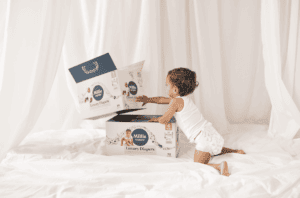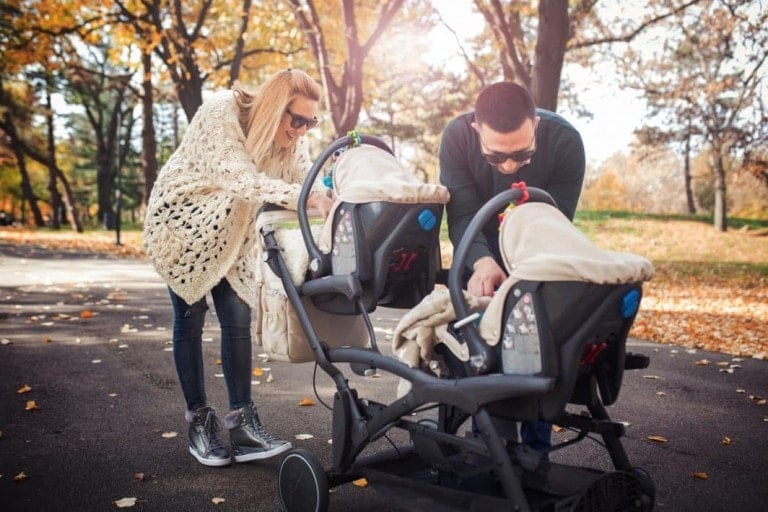Getting through the day with twins can feel like a huge accomplishment. You’re focusing on two babies, which means double the transitions and milestones. At what age should they be doing that? Is it normal for one twin to be more advanced than the other? Will the other catch up?
Having a clear picture of expectations regarding your twins’ transitions may help you better handle the ever-changing journey of raising twins!
1. Swaddles
While some babies love being swaddled, others prefer to be less constricted. Babies should start transitioning out of their swaddles by 3 months. This is optimal for shoulder development; having them out of the swaddle when they begin to roll over is important. It may be a bit later than 3 months with twins, as 50% are born prematurely.1 You’ll want to readjust their age to their due date instead of their date of birth and calculate transitions from there. This may be a more challenging transition for some babies and may be done gradually by taking one hand out of the swaddle for a couple of nights and then taking out the other arm. Because they have spent such a long time in NICU, where they are not swaddled, other twins may never take to a swaddle once home.
My daughter loved being swaddled and slept so well, being snug and cozy, but we had to take my son out of the swaddle before the 3 months. He was moving so much that he turned clockwise around the crib. The moment he rolled over to his stomach, he slept so much longer at night.
2. Sleeping
One of the biggest transitions for twins is when they finally sleep through the night! It’s a glorious day when they do. But this will be a challenge for the family, as you will be trying to synchronize two infants’ sleep patterns. If babies have been in the NICU, they will have already implemented a strict feeding routine. This will transfer when they are home, but the timing and age at which it is appropriate to start sleep training will vary based on the babies’ weight and your pediatrician’s recommendations for nighttime feedings.
If babies have spent time in the NICU, they can sleep train a bit later, between 5-7 months. Do not go by what your singleton mom friends are doing. Sleep training twins is a bit trickier! If they sleep in the same room, as most twins do, they innately can and will sleep through the others’ crying. My daughter was a bad sleeper, but my son, 2 feet away, would not be phased by her cries all night! It was beneficial when we sleep-trained them as she wouldn’t bother him. Eventually, around 7 months, they were both sleeping through the night with no night feedings.
The different types of techniques and methods of sleep training may vary from family to family and what parents are willing to accept and tolerate. Since there are two babies, these techniques may also differ from baby to baby. It is important to note that sleep training should be done when there are no significant life changes for your twins, like a change in routine or environment. They shouldn’t be sick with a cold or teething, as those things will not make the transition ideal.
3. Teething
Although parents may be delighted to see a pearly white appear in their babies’ mouths, this can be the start of a very trying time for both baby and parent. The teething milestone for your babies will be as hard for them as it is for you.
Babies will start budding their teeth between 4-7 months old. Some as early as 3 months and others well after their 1st year. Both of your babies may start teething at the same time. Dealing with the pain of their swollen gums and tireless nights will be exhausting for Mom and Dad. Our babies needed extra cuddles from Mom and Dad. One baby would rather drink her milk, as gumming food was too uncomfortable. My other baby preferred food, which put pressure on his gums, and he felt relief.
You may get two babies that will begin teething before the other. This may allow you to tend to the fussy baby a little easier as the other is not uncomfortable yet. But sure enough, as soon as you are out of the woods with one, your other baby will start teething. But hopefully, it will provide quality time because while one baby is sleeping, you’ll have the opportunity to be extra cuddly with the teething baby.
4. Rolling Over, Crawling, Walking
When you have twins, you will always compare and wonder when both will start crawling and walking. This one was tricky for me as my daughter was always so advanced in motor skills. I thought my son would never walk! He seemed to have no interest in moving. He was perfectly content just sitting or being carried around. My daughter was so desperate to be on the move and independent! My daughter sat up 2 months before my son did. She crawled at 8 months, and my son crawled at 10 months. My daughter walked at 14 months, and my son at 16, almost 17 months!
5. Potty-Training
Last but not least, the ever-challenging transition known as Potty-Training Twins! For my older child, potty training was the easiest thing we ever did. She turned 3 in May, and we potty-trained that July because she was starting school in September. It took 3 days. We didn’t use pull-ups or a baby potty. Instead, just real undies and in the toilet! She slept with nighttime diapers for 3-4 months but never woke up with a wet diaper after those first 3 days of training! Not once!
Flash forward to Potty-Training our Twins. They are June babies and were scheduled to start preschool in August. So I thought, “Great, they’ll turn 3, and I’ll do the same training with them as I did with their older sister.” Then it dawned on me that they were going to Summer Camp at the end of May, so they needed to be potty trained! I panicked as they weren’t 3 yet, and everyone I knew who had started before 3 was not as successful.
I’ll spare you the story, but their training experience was lengthy. Most of my friends’ kids had an easier potty-training transition at or after age 3. You can talk to your child, and they can talk to you to let you know their needs, making it much easier for everyone. One crucial piece of advice is to never put them back in a diaper during the daytime. This lets them think that since they have a diaper on, they don’t have to go to the potty in the toilet, which can be counter-productive.
Having twins, I know firsthand that it can be tricky as the early milestones approach. You’ve got this, mama!



























